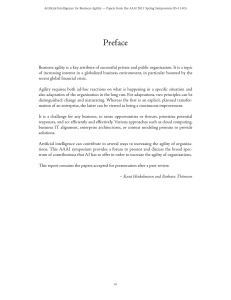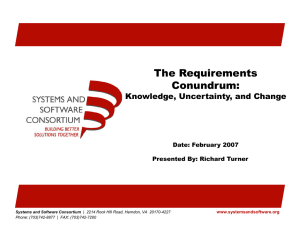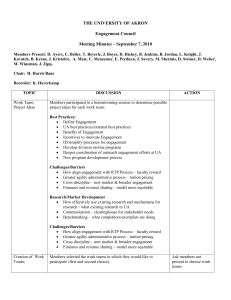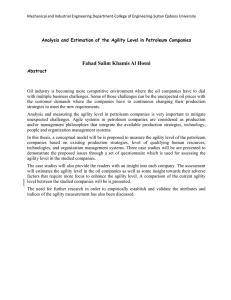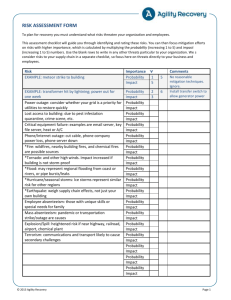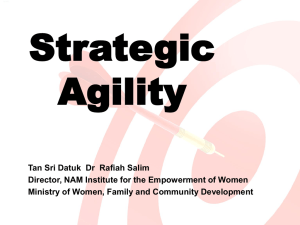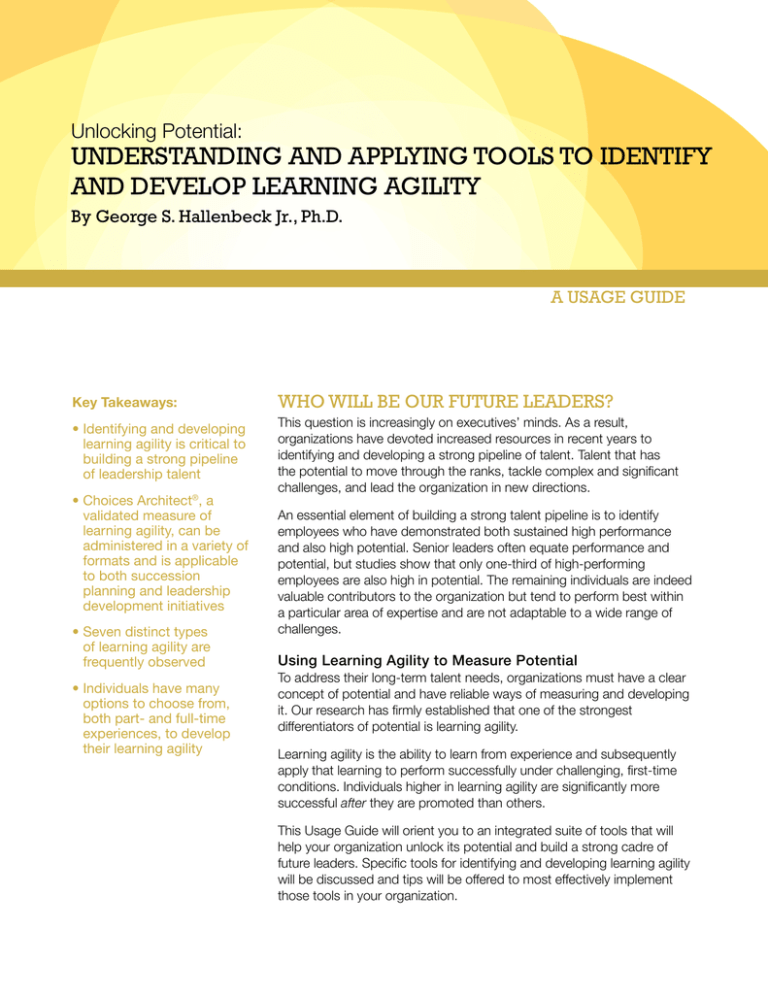
Unlocking Potential:
Understanding and Applying Tools to Identify
and Develop Learning Agility
By George S. Hallenbeck Jr., Ph.D.
A usage guide
Key Takeaways:
Who Will Be Our Future Leaders?
• Identifying and developing
learning agility is critical to
building a strong pipeline
of leadership talent
This question is increasingly on executives’ minds. As a result,
organizations have devoted increased resources in recent years to
identifying and developing a strong pipeline of talent. Talent that has
the potential to move through the ranks, tackle complex and significant
challenges, and lead the organization in new directions.
• Choices Architect®, a
validated measure of
learning agility, can be
administered in a variety of
formats and is applicable
to both succession
planning and leadership
development initiatives
• Seven distinct types
of learning agility are
frequently observed
• Individuals have many
options to choose from,
both part- and full-time
experiences, to develop
their learning agility
An essential element of building a strong talent pipeline is to identify
employees who have demonstrated both sustained high performance
and also high potential. Senior leaders often equate performance and
potential, but studies show that only one-third of high-performing
employees are also high in potential. The remaining individuals are indeed
valuable contributors to the organization but tend to perform best within
a particular area of expertise and are not adaptable to a wide range of
challenges.
Using Learning Agility to Measure Potential
To address their long-term talent needs, organizations must have a clear
concept of potential and have reliable ways of measuring and developing
it. Our research has firmly established that one of the strongest
differentiators of potential is learning agility.
Learning agility is the ability to learn from experience and subsequently
apply that learning to perform successfully under challenging, first-time
conditions. Individuals higher in learning agility are significantly more
successful after they are promoted than others.
This Usage Guide will orient you to an integrated suite of tools that will
help your organization unlock its potential and build a strong cadre of
future leaders. Specific tools for identifying and developing learning agility
will be discussed and tips will be offered to most effectively implement
those tools in your organization.
Identifying Learning Agility
Choices Architect® is a validated measure of learning agility. The 81
items in Choices Architect® measure four distinct factors of learning
agility: Mental Agility, People Agility, Change Agility, and Results Agility.
The four factors break down into 27 separate dimensions that provide
greater insight into an individual’s relative strengths and developmental
needs.
Choices Architect® is most often applied in the context of succession
planning to validate perceptions of an individual’s potential. It can be
applied in other ways, including for developmental purposes, which we
will discuss below.
Choices Architect® comes in various formats—online survey, paperbased questionnaire, and sort cards. This provides the user flexibility in
terms of how best to apply the measure. Each approach offers distinct
advantages and lends itself to particular applications. We will provide a
brief overview of each format and discuss when and how it might best
be applied.
The eChoices™ Online Survey – Useful for Evaluating
Learning Agility Around the Globe
The electronic version of Choices Architect®—the eChoices™ Online
Survey—is ideal for use when more than a dozen or so individuals are
going to be evaluated in terms of their learning agility and/or when
raters are participating from multiple locations. The survey is easily
administered through Lominger International’s Global Survey Center,
and reports are available in both paper and electronic formats.
2
Recent research has shown that rating patterns for learning agility are
quite consistent across different global regions, supporting our view that
learning agility is a quality that is normally distributed throughout the
population and doesn’t differ along lines such as age, gender, or level
in the organization. Learning agility, it seems, can be found just about
anywhere.
To support your organization’s efforts to search broadly for learning
agility, we have recently expanded the number of languages in which the
survey is available. The current list includes Spanish, French, German,
Italian, Brazilian Portuguese, Simplified Chinese, and Japanese.
Recent research has shown
that rating patterns for
learning agility are quite
consistent across different
global regions...
The survey is delivered to all raters in the same format (81 randomized
items) and takes about 15–20 minutes to complete. E-mail invitations
to raters can be customized to inform them about the organization’s
purpose for conducting the survey and to provide specific instructions.
The Global Survey Center will work with you to:
• Confirm rater assignments.
• Provide status completion reports.
• Issue reminders and process reports in a timely manner.
Reports come in a choice of two basic formats: a “short report,”
commonly used for succession planning purposes and a “long report,”
typically used for development purposes.
The eChoices™ Online Survey “Short Report” Format. This
report provides the necessary information that talent managers and
organizational leaders need to assess whether an individual meets the
criteria for having high levels of learning agility and should be designated
as having high potential. The report highlights an individual’s overall
learning agility score and how it ranks compared to our norms and also
provides scores on the four learning agility factors and 27 dimensions.
The raters for the short report are generally the individuals directly
involved in and responsible for making talent decisions for the
organization or a particular business unit. Raters typically include the
individual’s boss, the boss’s boss, and someone in a senior talent
management role. The individual being rated is typically not included
as a self-rater and in some instances may be unaware that he or she is
being rated.
3
Sample Participant
9/26/08
CHOICES® ARCHITECT
Multi-Rater Report
1
The Clearest
Example of This
MEAN
Better / More
Often Than Most
FACTORS
About Like Most
People
RANK
Less Often Than
Most
Not At All Like
This
Factor Summary
2
3
4
5
Unrated
Items
Lominger
Norm
Average
Norm
Percentile
1.0
Factor IV: Results Agility
4.25
2%
3.50
90
2.0
Factor I: Mental Agility
3.87
5%
3.33
84-86
3.0
Factor III: Change Agility
3.85
5%
3.33
78-81
4.0
Factor II: People Agility
3.79
2%
3.36
81
Excluding self as a rater is strongly recommended for two reasons:
The long report format is
ideal when the organization
wants to rate someone’s
learning agility purely for
developmental purposes.
1. Our best practices support keeping the succession planning
process a private one, at least until the organization has
established a highly refined and successful talent review process.
Transparency, while well-intentioned, can lead to difficulties,
particularly when individuals feel excluded or passed over.
2. Research consistently shows that individuals are not effective at
rating themselves on Choices Architect®— individuals rated low
by others typically overrate themselves, while the opposite is
true of individuals rated high by others in learning agility. These
discrepancies can lead to awkwardness, even conflict, especially
when individuals perceive their learning agility to be much higher
than others see it.
© Copyright 2007 LOMINGER INTERNATIONAL: A KORN/FERRY COMPANY. All Rights Reserved.
Page 11 of 57
The eChoices™ Online Survey “Long Report” Format. The long
report format is ideal when the organization wants to rate someone’s
learning agility purely for developmental purposes. This may occur at the
point where someone has already been confirmed by the organization
as a high potential or when the individual is working in a role that has a
high demand for learning agility in order to be successful.
Rater selection for the long report differs from the short report. Typically,
the rater list is expanded to include not only the boss and other seniorlevel raters, but also peers and direct reports. In this case, the individual
4
being rated is usually involved as a self-rater. The combination of
multiple, diverse raters and comparison between self and other ratings
gives the individual an experience more typical of a 360° feedback
survey and facilitates awareness and development.
Sample Participant
9/26/08
1.0
10.0
RATING ITEM
Factor IV: Results Agility
Dimension 24: Inspires Others
(Results Agility)
GROUP RANGE MEAN
1
3
4
Example of This
The Clearest
Often Than Most
People
About Like Most
Most
Less Often Than
2
5
GAP
INDICATOR
RANK
Not At All Like
H = among the 1/3 highest
L = among the 1/3 lowest
This
Group Summary
Better / More
CHOICES ARCHITECT®
Multi-Rater Report
H/L
Self
3-5
4.50
All Others
2-5
4.25
-0.25
H
Direct Manager(s)
3-5
4.42
-0.08
H
Other Manager(s)
2-5
3.63
-0.87
H
Peers
3-5
4.54
0.04
H
Direct Reports
3-5
4.38
-0.12
H
H
Self
3-4
3.33
All Others
2-5
3.98
Direct Manager(s)
3-5
4.00
0.67
Other Manager(s)
2-4
3.00
-0.33
L
Peers
4-5
4.67
1.34
H
Direct Reports
3-4
3.83
0.50
L
0.65
The eChoices™ Online Survey long report includes the same content as
the13.0short
report, plus two additional sections:
24. Can inspire a team to work hard.
Self
3-3
3.00
All Others
3-5
4.17
1.17
Direct Manager(s)
5-5
5.00
2.00
H
Other Manager(s)
3-3
3.00
0.00
L
Peers
4-5
4.50
1.50
Direct Reports
4-4
4.00
1.00
L
H
• An item report that features a rank-ordered list of scores on each
of the 81 survey items.
• A summary report that provides a breakdown of ratings from each
rating group for every item, dimension, and factor and highlights
self-other rating differences.
10.5
51. Can state his/her case or
viewpoint with energizing
passion.
Self
4-4
All Others
4-5
4.00
4.29
0.29
Direct Manager(s)
4-4
4.00
0.00
Other Manager(s)
4-4
4.00
0.00
H
Peers
5-5
5.00
1.00
H
Direct Reports
4-4
4.00
0.00
Choices Architect® Quick Score Questionnaire –
Ideal When You Need Instant Scoring
H
The Quick Score format provides a paper-based alternative to the
electronic survey and is ideal when a limited number of surveys are
being delivered or when instant scoring is required.
© Copyright 2007 LOMINGER INTERNATIONAL: A KORN/FERRY COMPANY. All Rights Reserved.
Page 27 of 57
Each Quick Score Questionnaire:
• Is designed to be completed by a single rater. (Completed
questionnaires can be gathered and quickly scored by accessing
the built-in scoring feature.)
5
• Yields precise overall learning agility and factor scores.
• Provides dimension-level results that can be interpreted visually.
In a succession planning setting, the raters could do a simultaneous
rating and scoring of an individual and then immediately discuss the
results. In a coaching and development setting, the coach and learner
could each fill out the questionnaire, score, compare results, and share
their insights.
Choices Architect® Sort Card Deck and Quick Reference
Guide – A Hands-On Approach for Assessing Learning
Agility
Choices Architect® Sort Cards can be used for the same purposes
as the electronic and paper surveys. The only difference is the
methodology—raters sort individual item cards and complete the
scoring process using a system of scoring sheets.
The sort cards also provide applications that the electronic and paperbased tools do not. In particular, cards can be sorted using what is
called a “flat sort” methodology that evenly divides items into categories.
Instead of yielding a specific score, a flat sort offers a comparison of the
relative strength or importance of different dimensions or factors. This
is very useful when comparing the relative strengths of team members
or trying to determine which dimensions or factors of learning agility are
most important for a particular job role.
An accompanying manual, the Choices Architect® Quick Reference
Guide, provides specific guidelines for conducting a variety of card
sorts. The highlighted applications include:
•A
ssessing Potential
• Selecting People for Developmental Assignments
• Assessing Teams
•A
ssessing Development Needs of High Potentials
• Profiling Jobs, Situations, or Tasks
Choices Architect® Technical Manual – Documents the
Research Foundation for Learning Agility
The Choices Architect® Technical Manual provides insight into the
research underpinnings for Choices Architect®. The manual includes
6
overviews of validation studies, a summary of research findings,
percentile charts, references, and FAQ responses. This manual is
essential for individuals who are responsible for being subject-matter
experts for the application of Choices Architect® in their organization as
well as for those who are undertaking their own applied research efforts
using the instrument.
Getting Started with Choices Architect®
Choices Architect® is a restricted set of tools, meaning that certification
is required from Korn/Ferry Leadership and Talent Consulting to
administer and interpret the survey results and provide feedback. Public
and in-house certifications are readily available that cover the research
basis for Choices Architect®, review the purpose of each tool, and
provide recommendations and practice in applying them.
Before applying Choices
Architect®, it is very
important to define the
specific purpose for which
the tool will be applied.
Following certification, the Choices Architect® tools can be purchased
directly from Lominger International and applied by certified practitioners.
In the case of the eChoices™ Online Survey, the Global Survey Center
will guide you through a one-time client set up process and then work
with you to launch and administer subsequent survey engagements.
Tips for Using Choices Architect®
Before applying Choices Architect®, it is very important to define the
specific purpose for which the tool will be applied, who will be rated,
who will conduct ratings, the specific method to be used, and how the
process will unfold. A pre- and post-implementation communication plan
is also essential.
There are many correct ways to implement Choices Architect®
depending on the particular purpose, the people involved, and how the
evaluation of learning agility relates to other talent management efforts.
Every situation presents a unique set of implementation considerations.
However, there are two practices we consistently recommend as part of
any Choices Architect® implementation, particularly in the early stages:
Every situation
presents a unique set
of implementation
considerations.
1. Make sure you have spent sufficient time orienting key
stakeholders to what learning agility is and why it is important.
Typically, a two-hour interactive workshop with senior managers
that might incorporate a sample card sort or an overview of an
eChoices™ Online Survey report is a good way to get started.
The sooner a person understands what learning agility looks like
7
in behavioral terms and how it is critical to the organization’s
talent management efforts, the better positioned he or she will
be to deliver valid ratings and make informed decisions using the
tool.
The sooner a person
understands what
learning agility looks
like in behavioral terms
and how it is critical to
the organization’s talent
management efforts, the
better positioned he or
she will be to deliver valid
ratings and make informed
decisions using the tool.
2. Avoid the temptation to roll out Choices Architect® on a grand
scale. Instead, pick a target population for a pilot run. This
approach helps ensure you are applying the tool in the manner
you intended, resolves any questions you might have, and makes
any necessary adjustments to the process before going forward.
Resources from Korn/Ferry Leadership and Talent Consulting can
assist you and help guide your efforts during this initial phase.
Acquiring a Choices Architect® Intellectual Property
License
After applying Choices Architect® for a period of time, many
organizations show an interest in taking some of the language related
to learning agility and embedding it into other aspects of their talent
management operations and/or making some modifications to the
content to fit their particular needs.
To facilitate this process, we provide our clients with the opportunity
to acquire an intellectual property license. This gives you the freedom
and flexibility to apply the Choices Architect® content in a way that best
fits your needs and seamlessly blends it into your practices. If you are
interested in finding out more about an intellectual property license,
contact our licensing department at licensing@kornferry.com.
Frequently Asked Questions
We have included some of the most commonly asked questions
about our Choices Architect® tools and the process of measuring
learning agility. If you have more questions, you may want to contact
us at customerservice@kornferry.com or by calling +1 877-345-3610
(US/Canada) or +1 952-345-3610 (International).
8
1. What if someone I consider to be a high potential doesn’t score
high in learning agility?
This may mean that your initial evaluation of the individual’s
potential was not accurate. This should not be a disappointing
result since the very nature of the tool is to help you validate your
perceptions of potential and make sure that valued employees
are not being put on a career path that will not benefit either them
or the organization.
In the case where someone scores in the high average range of
learning agility, but not in the upper percentiles, then this provides
a good opportunity to construct a development plan that will
target opportunities for enhancing his or her learning agility.
2. What if raters differ in their perceptions of an individual’s learning
agility?
This will happen on occasion, and it is worthwhile to engage in a
facilitated discussion where the different parties can provide their
perceptions and make comparisons. It is not necessary to reach
consensus, but often an exchange of views can cause one or
more of the raters to gain additional perspective.
3. Can I rate a high-potential candidate on the competencies most
closely linked to learning agility as a substitute measure for
Choices Architect®?
This is an appealing idea, but it does not work quite as well in
practice. First of all, the competencies are differentially weighted
in their relationship to learning agility, so this makes scoring
very difficult. Second, there are over 25 separate competencies
with links to learning agility. Creating a comprehensive measure
and gathering and integrating the data in this way takes as
much, if not more, effort as it would to administer Choices
Architect®. Finally, attempting to assess learning agility via related
competencies would likely need to be done using the VOICES®
survey. VOICES® is a competency-based developmental feedback
instrument, and is not designed as a learning agility assessment.
Applying VOICES® in this manner could lead to confusion and
other complications.
4. Can I do a shortened version of Choices Architect®, using just the
items I want to include?
Choices Architect® results not based on the complete 81-item
survey are not considered valid, and it is not advised to base
any decisions regarding potential or advancement on incomplete
scores. Also, measuring just a portion of learning agility, say one
or two factors, provides an incomplete view since it is a very
complex construct.
In the case where someone
scores in the high average
range of learning agility, but
not in the upper percentiles,
then this provides a good
opportunity to construct
a development plan that
will target opportunities
for enhancing his or her
learning agility.
9
Learning from Experience™ – An Alternate Means of
Assessing Learning Agility
In addition to Choices Architect®, the Learning from Experience™ (LFE)
Interview Guide provides an alternate means for assessing learning
agility. A structured, behavior-based interview approach provides specific
questions for assessing each of the four factors of learning agility.
LFE has an added advantage in that it can be applied to external
selection. Choices Architect® requires raters to be well-acquainted with
the person being rated in order to yield valid results. LFE, on the other
hand, can be applied successfully when the person being interviewed is
not familiar or well-known.
LFE is an excellent complement to the results from a Choices Architect®
survey as it provides both validation and a deeper insight into the
specific ways an individual applies and leverages his or her learning
agility. This lends value in both succession planning and development
applications.
Developing Learning Agility
Identifying learning agility is just the start. Potential is not static in nature.
A high potential today is not necessarily a high potential tomorrow.
Without new challenges and experiences to inform learning and new
opportunities to apply those lessons learned, learning agility can grow
stale. Also, even individuals who are high in learning agility may have
lower scores in several dimensions. Therefore, continuing to nurture and
reinforce learning agility is a high priority.
Two specific resources are available to support and enhance efforts
at developing learning agility: High Learning Agility Profiles and FYI for
Learning Agility™.
High Learning Agility Profiles – Highlights Seven Distinct
Types of Learning Agility
10
Learning agility is a complex set of characteristics. Therefore, it is not
surprising that learning agile people, while sharing some common traits,
also tend to differ in terms of their specific learning agility strengths
and weaknesses. Recent research has revealed that there are seven
distinct types of high learning agile people that are frequently observed.
Understanding an individual’s particular learning agility profile has
implications for determining how to best deploy and develop that
person’s talents.
High Learning Agility Profiles:
• Provide an overview of each of the seven profiles, highlighting their
unique nature and underscoring the impact that people who fit
that profile can have on the organization. Individuals can identify
which of the seven profiles best fit them. They are also prompted
to consider the situations that favor their learning agility strengths
as well as what situations will provide the best opportunities for
developing their learning agility.
• Work best when the individual has the results from a recent
Choices Architect® survey and the opportunity to work with a
coach who is knowledgeable about learning agility.
• Can be incorporated into a Choices Architect® feedback session
or as part of a follow-up coaching discussion.
•C
an be used in the context of succession planning to extend the
discussion about what are the best next steps for a high potential
and can help to differentiate that person from other high potentials.
•C
an be used when several learning agile people are working
together in a team setting. By understanding their own profile and
the profiles of their team members, individuals can gain better
insight into their specific contribution to the team as well as how to
best leverage their peers’ talents.
FYI for Learning Agility™
is a valuable resource
for formulating detailed
next steps and allows the
learning agile person and
his or her coach to focus
deeper on how to develop
specific dimensions of
learning agility.
FYI for Learning Agility™ – Provides Key Remedies for
Developing Learning Agility
While the High Learning Agility Profiles tool provides an overall
framework for looking at an individual’s learning agility and what that
might mean for his or her career, FYI for Learning Agility™ is a valuable
resource for formulating detailed next steps and allows the learning agile
person and his or her coach to focus deeper on how to develop specific
dimensions of learning agility.
FYI for Learning Agility™:
• Is designed for any motivated person seeking to develop skills
that lead to increased learning agility. The suggestions provided
are aimed at gaining insight on learning strengths and remedying
skill needs. The content will also help anyone who is serving as a
manager, mentor, or feedback giver.
11
• Is divided into 27 chapters—one for each dimension of learning
agility. Each chapter includes a detailed definition of the
dimension, 10 practical, easy-to-implement tips for development,
part-time and full-time job assignments that provide good
opportunities for developing in the dimension, and a list of
suggested readings.
• Plays an important role in coaching individuals, but it can also be
applied to formulating development strategies based on aggregate
Choices Architect® results for a group of high potentials.
• Is also an excellent all-purpose resource for understanding each
dimension of learning agility in greater detail. The more a coach
or talent manager understands the nuances of learning agility, the
better he or she is positioned to spot learning agile characteristics
in others and determine the best course of action.
Acquiring an FYI for Learning Agility™ Intellectual Property
License
As with Choices Architect®, the content from FYI for Learning Agility™
is available for licensing so that it can be customized and embedded
into an organization’s solutions. For example, specific development
suggestions can be incorporated into the development planning
materials for the organization’s high potential coaching program.
Similarly, job assignments most effective for developing particular
dimensions or factors of learning agility can be highlighted as part of the
“next steps” discussion in the organization’s talent review process. If you
are interested in finding out more about an intellectual property license,
contact our licensing department at licensing@kornferry.com.
Additional Development Resources – Broadband Talent
Management™ and FYI For Your Improvement™
Additional resources are available to support ongoing development
efforts with high potentials. Depending on the particular nature of the
individual’s development needs, Broadband Talent Management™ and
the companion Paths to Improvement: A Coaching Reference Guide
for Broadband Talent Management™ provide an array of strategies
to choose from for pursuing development. These include direct
approaches like a Good to Great Plan or employing more creative
approaches like a Workaround Plan or a Marketing Plan.
12
FYI For Your Improvement™ incorporates many of the same features
as FYI for Learning Agility™ and provides remedies for each of the 67
Leadership Architect® Competencies (as well as the 19 Career Stallers
and Stoppers). Each chapter in FYI for Learning Agility™ provides a list
of Leadership Architect® Competencies that are closely linked (Strong,
Moderate, or Light) to each dimension of learning agility. This allows for
simultaneous development by targeting the specific competencies that
support a learning agility dimension.
Tips for Developing Learning Agility
Any effort at development, whether it is aimed at learning agility or
competencies, will not be as successful unless the individual being
coached is aware that he or she has a need, accepts that need, and
is motivated to do something about it. Adhering to best practices
when delivering feedback and taking the time to work through any
defensiveness or blind spots that the individual has is key to this effort.
Also, treat each individual’s set of development needs and
corresponding solutions as unique. While it is good to have some
reliable solutions to apply and an idea of what has tended to work well in
the past, make sure to approach each situation with a fresh perspective
and involve the individual in crafting a set of development strategies that
best suits his or her needs.
Any effort at development,
whether it is aimed
at learning agility or
competencies, will not be
as successful unless the
individual being coached is
aware that he or she has a
need, accepts that need, and
is motivated to do something
about it.
Frequently Asked Questions
We have included some of the most commonly asked questions about
developing learning agility in individuals. If you have more questions,
you may want to contact us at customerservice@kornferry.com
or by calling +1 877-345-3610 (US/Canada) or +1 952-345-3610
(International).
1. Are some aspects of learning agility more difficult to develop than
others?
Yes. Each individual dimension has a level of developmental
difficulty associated with it (these are listed in FYI for Learning
Agility™) and the levels range from Easy to Hard. If you aggregate
developmental difficulty across the four learning agility factors,
People Agility and Change Agility emerge as the most difficult to
develop and Results Agility is the easiest.
13
2. How long does it take to develop learning agility?
This depends both on how much development needs to take
place and how difficult a particular dimension is to develop. In
general, learning agility is not something that is developed quickly
or easily, in part because experience itself plays a critical role.
As a rule of thumb, allow nine months or so for a particular job
experience to yield some substantive lessons and roughly an
equal amount of time to gain experience with applying those
lessons to new challenges.
3. How much can I expect to develop my learning agility?
This depends on where you are now in terms of your skill level
and how far you are looking to progress. If you were to give
yourself the equivalent of a letter grade in learning agility, it is
reasonable that you might be able to move up one letter grade
in skill over time. In general, the further advanced you already are
in your learning agility, the better your prospects for continued
development, in part because you show a strong tendency
towards growth and adaptability. Put another way, someone
who is a high performer but low in learning agility is not likely
to transform into a true high potential. It is better to emphasize
continued growth in the areas where he or she already
demonstrates some comfort and expertise.
4. What are the best experiences for developing learning agility?
There is not a “one best experience” for developing learning
agility overall or even for a particular dimension or factor.
Generally, there are many options to choose from, both parttime and full-time experiences. FYI for Learning Agility™
highlights a number of specific experiences that provide good
opportunities for development for each learning agility dimension.
The determination of which experience might provide the best
opportunity should be a decision between the individual looking
to develop and his or her coach.
There is not a “one best
experience” for developing
learning agility overall
or even for a particular
dimension or factor.
Generally, there are many
options to choose from,
both part-time and full-time
experiences.
Getting the Most out of Learning Agility in Your Organization
14
Our intent with this Usage Guide is to provide you with an informative
overview of the tools available for identifying and developing learning
agility in your organization. Applied correctly, they will help to unlock
the sources of potential in your organization and establish a strong and
enduring pipeline of future leaders.
The key lies in having a clear purpose and plan for applying the tools
and being learning agile in your approach to applying them. Continually
seek feedback on your efforts to incorporate the tools into your talent
management efforts, be open to the lessons learned, seize opportunities
to apply them, and continually experiment with new and refined
approaches.
Finally, take steps to establish an organizational culture and environment
that nurtures and reinforces learning. A learning culture encourages
employees to share information, provide feedback to each other, and
try innovative solutions. The development of employees’ learning agility
doesn’t happen coincidentally. Learning and development is less likely to
occur when the organization environment does not support it. A learning
culture starts at the top with leaders who truly respect the value of
learning and are willing to demonstrate that respect and set an example
for others through their actions.
The key lies in having a
clear purpose and plan
for applying the tools and
being learning agile in your
approach to applying them.
15
George Hallenbeck, Ph.D., is Director,
Intellectual Property Development with Korn/Ferry
Leadership and Talent Consulting.
About Korn/Ferry International
Korn/Ferry International, with more than 90 offices in 39 countries, is
a premier global provider of talent management solutions. Based in
Los Angeles, the firm delivers an array of solutions that help clients to
identify, deploy, develop, retain and reward their talent.
For more information on learning agility and the tools highlighted in this
Usage Guide, please visit our Web site at www.lominger.com or contact
Customer Service at customerservice@kornferry.com or by calling
+1 877-345-3610 (US/Canada) or +1 952-345-3610 (International).
16

